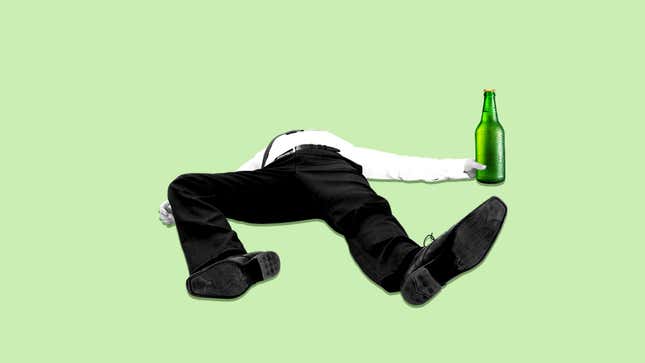
Now that the holidays are over, a bit of reflection is in order. The days were short, the nights long, and the awkward, forced social interactions all too frequent. Many of us breezed through uncomfortable office holiday parties or family dinners with the aid of alcohol; some drank too much, others drank way too much.
Not surprisingly, alcohol consumption tends to spike over the holidays. But how do we know when the ruddy little cousin in the Rudolph sweater who's never really known when to say when has transitioned from the bro with the high tolerance to the bro who's an alcoholic?
First, it's important to define our terms. Alcoholism is a word we've all used, but it means different things to different people. In medicine, "alcoholism" sometimes encompasses both alcohol abuse and alcohol dependence—vague terms that denote a problematic relationship with alcohol—but what do they actually mean?
To help clarify things, the American Psychiatric Association recently revised its manual, the Diagnostic and Statistical Manual of Mental Disorders, Fifth Edition (DSM-5), and changed the way we talk about alcoholism.1 "Alcohol abuse" and "alcohol dependence" were replaced by a single diagnosis: "alcohol use disorder." The change deemphasized the sheer quantity of booze consumed and gave greater importance to symptomatology. To be diagnosed with alcohol use disorder, one must exhibit a problematic pattern of alcohol use—not just an isolated holiday binge—as well as two or more of the following within a 12-month period:
- Alcohol is often taken in larger amounts or over a longer period than was intended
- There is a persistent desire or unsuccessful efforts to cut down or control alcohol use
- A great deal of time is spent in activities necessary to obtain alcohol, use alcohol, or recover from its effects
- Craving, or a strong desire or urge, to use alcohol
- Recurrent alcohol use resulting in a failure to fulfill major role obligations at work, school, or home
- Continued alcohol use despite having persistent or recurrent social or interpersonal problems caused or exacerbated by the effects of alcohol
- Important social, occupational, or recreational activities are given up or reduced because of alcohol use
- Recurrent alcohol use in situations in which it is physically hazardous
- Continued alcohol use despite knowledge of having a persistent or recurrent physical or psychological problem that is likely to have been caused or exacerbated by alcohol
- Tolerance, as shown by a diminished effect when drinking the "usual" amount or a need for increasing amounts to achieve the desired effect
- Withdrawal
But some people aren't interested in symptoms; they want numbers. Fine, here: According to the National Institute on Alcohol Abuse and Alcoholism, men put themselves at risk for alcohol use disorder if their alcohol consumption exceeds 14 drinks per week and women may be at risk if they have more than seven standard drinks per week. (A standard drink is defined as one 12-ounce bottle of beer, one 5-ounce glass of wine, or a 1.5-ounce shot of liquor.)
Of course, the holidays are a time when many drink to excess. For some, the increased consumption is transient; for others, it's not. It's important to remember that even if you can consistently show up for work on time after a night of heavy boozing, you may still be doing irreparable damage to your liver—in the medically problematic way, not the "Oh geez we drink too much, OUR LIVERS!" way. You might not blackout or vomit or get hangovers, but the absence of those symptoms doesn't make the amount of booze any less dangerous, in a way you won't even feel.
So if you or someone you know seems to have an unhealthy relationship with alcohol, do two things: tally up the number of drinks that person consumes in an average week and review the symptoms provided above. If there's an issue, reach out to a health professional.
1 Our country consumes an insane amount of booze. In a 2008 survey, just over half of Americans over the age of 12 reported being active drinkers (which translates into 129 million drinkers in the United States). In one study, 16 percent of eighth graders had consumed five or more drinks at one sitting within the last two weeks.
Image by Sam Woolley; original photo via Shutterstock
Matt McCarthy is board-certified in internal medicine. You can follow him on Twitter here.